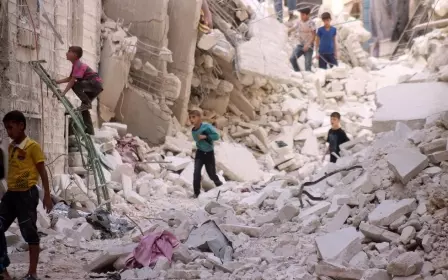Iran 'transformed' Syrian army into militia: analysis

The Syrian conflict will enter its fourth year in March 2015, but continuous Iranian support for the government of president Bashar al-Assad will ensure that his forces will carry on fighting for at least another year, according to observers.
Those forces, however, no longer resemble a traditional national army. Instead, they have been increasingly behaving like sectarian militias.
"When regime forces opened fire on protesters, sparking the initial rebellion, thousands of soldiers defected to the opposition," wrote David Axe, a military correspondent, in an article published in Reuters blogs
Syria's standing army has lost around half of its manpower.
"Defections, desertions and attrition after three years of civil war saw Syria's total manpower decline from a high of 325,000 in 2011 to 295,000 in 2012 to an estimated 178,000 in 2013 and 2014," Aram Nerguizian, a military affairs expert from the Centre for Strategic and International Studies, told AFP.
To fill the gap, Tehran helped Assad recruit volunteers to be part of armed units, led by the Iranian Revolutionary Guard Corps officers.
"By 2014, the old Syrian army was a spent force," noted Axe, prompting Iran to replace "the Syrian army with a militia called the National Defence Force (NDF), which draws many of its volunteers from the Alawite religious group — the regime's main supporters."
According to the UK-based monitoring group, the Syrian Observatory for Human Rights, more than 24,000 NDF volunteers have died in combat.
"But there are three million Alawites in Syria, more than enough to sustain the National Defence Force for years to come, barring an unlikely collapse in Alawite support for the regime," said Axe.
Pro-Assad forces are not expected to secure a crushing defeat against their opponents, but neither are the rebels or militants.
"The rebels still struggle to obtain heavy weaponry for their two-front war. For their part, Islamic State militants have picked simultaneous fights with the Syrian regime, the Free Syrian Army, Iran, Iraq and a growing US-led coalition," noted Axe.
High stakes for Syria's Alawite community
One factor that has been suggested as a potential game-changer is the Alawite community, on whose support has relied throughout the civil war.
The Alawites, who make up some 12 percent of the population, top the ranks of Syria's professional army and security services.
However, in recent months analysts say cracks have been appearing in the community, whose members span the socio-economic spectrum in Syria.
In July, a group of Alawite activists launched the Speak Up Against Assad campaign, protesting against the high numbers of deaths among Alawites during the war.
Then, in October, a group calling itself the Syrian Alawite Congregation issued a statement calling on Alawites to "take a stand against Assad’s regime," also citing high death rates among their community.
The statement alleged that Alawites were targeted for conscription in the pro-Assad paramilitaries, "because the President believes they are most faithful to him."
If these cracks deepen, and significant numbers of Assad's sect come out against him, the results would be catastrophic for Assad.
"If the Alawites started to fight amongst themselves, the whole edifice would collapse," said Joshua Landis, director of the Centre for Middle East Studies at the University of Oklahoma.
The group, long seen as receiving favoured positions and greater power in Syrian society, would be extremely vulnerable to attack from the forces battling against Assad.
"For the time being," Landis said, "that threat is enough to keep them together."
Billions of dollars of funding
The conflict has been sustained by billions of dollars of funding poured in to support the different warring sides.
Wealthy Gulf funders will not have a free hand in funnelling money into Syria after members of the Gulf Co-operation Council vowed in December to fight extremist groups, calling for their resources to be dried up.
And the $150 a month wages for some "moderate" fighters have been abruptly halted, it was reported last week.
On the Syrian government side, international sanctions are biting on Assad's income streams, and his backers in Tehran and Moscow have less money to dispose of outside their borders.
"Nobody yet knows what impact this collapse in oil prices will have – both Iran and Russia have already been seriously affected. What the trickle-down effects of that will be on Assad’s finances is hard to know - but it will clearly be very bad," said Landis.
But Landis doubts the funding crisis will brighten the prospects for peace, predicting "the fragmentation in Syria will continue unabated."
"Neither side is anywhere near defeat, and neither side is anywhere near victory."
Stay informed with MEE's newsletters
Sign up to get the latest alerts, insights and analysis, starting with Turkey Unpacked
Middle East Eye delivers independent and unrivalled coverage and analysis of the Middle East, North Africa and beyond. To learn more about republishing this content and the associated fees, please fill out this form. More about MEE can be found here.




